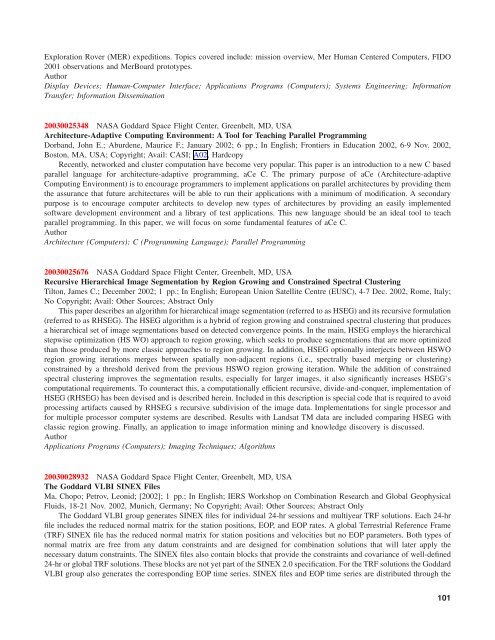Create successful ePaper yourself
Turn your PDF publications into a flip-book with our unique Google optimized e-Paper software.
Exploration Rover (MER) expeditions. Topics covered include: mission overview, Mer Human Centered Computers, FIDO<br />
2001 observations and MerBoard prototypes.<br />
Author<br />
Display Devices; Human-Computer Interface; Applications Programs (Computers); Systems Engineering; Information<br />
Transfer; Information Dissemination<br />
20030025348 NASA Goddard Space Flight Center, Greenbelt, MD, USA<br />
Architecture-Adaptive Computing Environment: A Tool for Teaching Parallel Programming<br />
Dorband, John E.; Aburdene, Maurice F.; January 2002; 6 pp.; In English; Frontiers in Education 2002, 6-9 Nov. 2002,<br />
Boston, MA, USA; Copyright; Avail: CASI; A02, Hardcopy<br />
Recently, networked and cluster computation have become very popular. This paper is an introduction to a new C based<br />
parallel language for architecture-adaptive programming, aCe C. The primary purpose of aCe (Architecture-adaptive<br />
Computing Environment) is to encourage programmers to implement applications on parallel architectures by providing them<br />
the assurance that future architectures will be able to run their applications with a minimum of modification. A secondary<br />
purpose is to encourage computer architects to develop new types of architectures by providing an easily implemented<br />
software development environment and a library of test applications. This new language should be an ideal tool to teach<br />
parallel programming. In this paper, we will focus on some fundamental features of aCe C.<br />
Author<br />
Architecture (Computers); C (Programming Language); Parallel Programming<br />
20030025676 NASA Goddard Space Flight Center, Greenbelt, MD, USA<br />
Recursive Hierarchical Image Segmentation by Region Growing and Constrained Spectral Clustering<br />
Tilton, James C.; December 2002; 1 pp.; In English; European Union Satellite Centre (EUSC), 4-7 Dec. 2002, Rome, Italy;<br />
No Copyright; Avail: Other Sources; Abstract Only<br />
This paper describes an algorithm for hierarchical image segmentation (referred to as HSEG) and its recursive formulation<br />
(referred to as RHSEG). The HSEG algorithm is a hybrid of region growing and constrained spectral clustering that produces<br />
a hierarchical set of image segmentations based on detected convergence points. In the main, HSEG employs the hierarchical<br />
stepwise optimization (HS WO) approach to region growing, which seeks to produce segmentations that are more optimized<br />
than those produced by more classic approaches to region growing. In addition, HSEG optionally interjects between HSWO<br />
region growing iterations merges between spatially non-adjacent regions (i.e., spectrally based merging or clustering)<br />
constrained by a threshold derived from the previous HSWO region growing iteration. While the addition of constrained<br />
spectral clustering improves the segmentation results, especially for larger images, it also significantly increases HSEG’s<br />
computational requirements. To counteract this, a computationally efficient recursive, divide-and-conquer, implementation of<br />
HSEG (RHSEG) has been devised and is described herein. Included in this description is special code that is required to avoid<br />
processing artifacts caused by RHSEG s recursive subdivision of the image data. Implementations for single processor and<br />
for multiple processor computer systems are described. Results with Landsat TM data are included comparing HSEG with<br />
classic region growing. Finally, an application to image information mining and knowledge discovery is discussed.<br />
Author<br />
Applications Programs (Computers); Imaging Techniques; Algorithms<br />
20030028932 NASA Goddard Space Flight Center, Greenbelt, MD, USA<br />
The Goddard VLBI SINEX Files<br />
Ma, Chopo; Petrov, Leonid; [2002]; 1 pp.; In English; IERS Workshop on Combination Research and Global Geophysical<br />
Fluids, 18-21 Nov. 2002, Munich, Germany; No Copyright; Avail: Other Sources; Abstract Only<br />
The Goddard VLBI group generates SINEX <strong>file</strong>s for individual 24-hr sessions and multiyear TRF solutions. Each 24-hr<br />
<strong>file</strong> includes the reduced normal matrix for the station positions, EOP, and EOP rates. A global Terrestrial Reference Frame<br />
(TRF) SINEX <strong>file</strong> has the reduced normal matrix for station positions and velocities but no EOP parameters. Both types of<br />
normal matrix are free from any datum constraints and are designed for combination solutions that will later apply the<br />
necessary datum constraints. The SINEX <strong>file</strong>s also contain blocks that provide the constraints and covariance of well-defined<br />
24-hr or global TRF solutions. These blocks are not yet part of the SINEX 2.0 specification. For the TRF solutions the Goddard<br />
VLBI group also generates the corresponding EOP time series. SINEX <strong>file</strong>s and EOP time series are distributed through the<br />
101
















